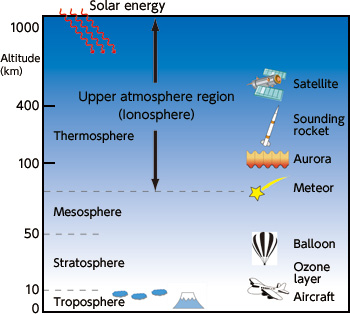TOP > Report & Column > The Forefront of Space Science > 2012 > Research on the Upper Atmosphere Region Using Sounding Rockets
![]()

What exists beyond the blue sky? Many people may answer "the universe." There are a variety of regions above, however, including the troposphere up to an altitude of about 10 km where clouds exist and, above it, the stratosphere, the mesosphere and the thermosphere (Fig.1). Outer space above an altitude of approx. 80 km is called the ionosphere since part of the atmosphere there is ionized. The ionosphere is unique, differing from both the earth we live on and the universe. In this article, I will use the general term "Upper Atmosphere Region" for the ionosphere and introduce its characteristic and current research on it. 
The most distinguishing character of the upper atmosphere region is its composition. The earth's lower atmosphere is filled with only neutral atmosphere while plasma (i.e., ionized atmosphere) accounts for more than 99% in outer space. In the upper atmosphere region, however, neutral atmosphere and plasma co-exist. Unlike the atmosphere, plasma moves by being influenced by electric and magnetic fields. Moreover, collisions occur between them. Thus, plasma particles under the influence of electromagnetic field are moved by repeatedly colliding with atmospheric particles. There are no other regions that exhibit this phenomenon. The upper atmosphere is relatively close to the region where we live, so we have a long history of observing it compared to other outer space regions. Many unsolved questions remain, however, mainly because the atmosphere and plasma co-exist there and a way of the direct observation is limited. Although we can use satellites to conduct long-term observation of space above an altitude of 250km, the region between 80 to 200km altitudes is too low for satellite observation and too high for balloon observation. Hence it is difficult to perform a long, continuous observation of the region. Ground-based observation is suitable for continuous monitoring, but it is not appropriate for studying small-scale phenomena. Consequently, the upper atmosphere is considered a region for which the least data set is available in terms of the direct observation time. One method to enable in-situ observation of the upper atmosphere region is to use sounding rockets. The rockets can carry science instruments in its nose cone section and enable us to measure during flight. In case of scientific satellites, the observations are started after it is released from launchers and is put into orbit. In case of the sounding rockets, observations are made only while they are flying. The Institute of Space and Astronautical Science (ISAS) has launched various sounding rockets such as K (kappa)-type and S-type. Table 1 lists the sounding rockets launched since 2000 and shows that a variety of experiments have been conducted. This article shows how our research was conducted by describing three examples of the experiment.
|
||||||||||||||||||||||||||||||||||||||||||||||||||||||||||||||||||||||||||||||




